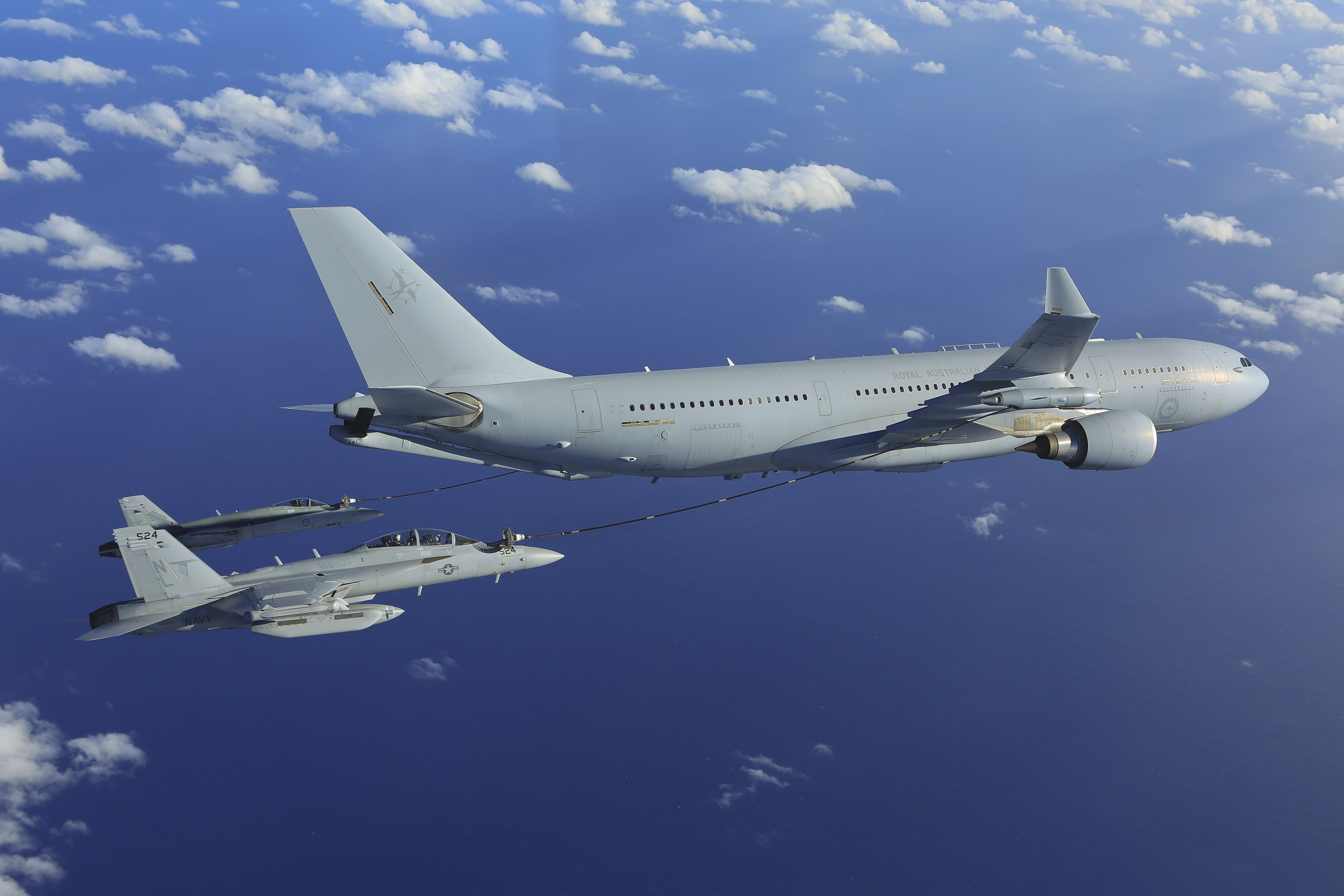The Aussie A330MRTT to the Rescue Over the Skies of Iraq: 2015
The KC-30A has become a key element of the Australian expeditionary force.
And the plane is a key enabler of Plan Jericho where the Royal Australian Air Force is focused upon shaping innovative 21st century concepts of operation.
One of those changes is battlespace awareness and moving the tanker to the fight.
In an interview with recently retired RAAF Chief of Staff Geoff Brown, the role of the KC-30A was highlighted.
Question: Clearly, when you launched Plan Jericho, you were focused on tapping into the operational community and unleashing creativity inherent within that community.
Could you discuss your thinking in that regard?
Air Marshal (Retired) Brown: I think the KC-30A operators are a good case in point.
It is about changing what you call the mental furniture.
Here the KC-30A operators were looking at their role in the battlespace and working out new ways to execute the mission rather than the traditional way of flying around in tanker tracks and operating as a flying gas station.
They understand that they were not simply flying gas stations but a key asset in the battlespace enabling the fighters and all air assets for that matter.
The crew looked at their operational situation and determined ways to move closer to those fighter assets and anticipated when the fighters would need to be refueled BEFORE those fighters even asked for fuel.
When I was onboard the KC-30A over Iraq, and saw the operators determine that Marine Corps F-18s engaged over an area of interest, and the tanker crew then determined when they thought the Marines would need fuel and moved closer to them and picked a refueling spot and put out the hoses to get ready to tank the USMC Hornets BEFORE the Marines even had requested refueling.
That is the kind of change which we want to encourage in the RAAF.
The Marines were expecting to need 112,000 pounds of fuel for the mission but because of the repositioning of the tanker, they only needed 84,000 pounds.
You clearly are not always going to operate the tanker that way, but the point is that our tanking crew is involved and integrated into the battlespace and are thinking in terms of dynamic operations, not in any static sense.
In a real world warfighting perspective, the KC-30A with the crew’s battlefield awareness and operational agility has come to the aid of a UMSC F-18 over the skies of Northern Iraq.
In an Australian first, a RAAF KC-30A Multi-Role Tanker Transport has refueled a United States Marine Corps (USMC) F/A-18C Hornet with engine trouble over Iraq.
The USMC Hornet was flying a combat mission against Daesh over Northern Iraq when it was forced to shut down one of its two engines due to a mechanical issue.
Short on fuel, the Hornet requested air-to-air refueling support from the RAAF KC-30A.
A challenging feat at the best of times, air-to-air refueling with an engine-out Hornet had only ever been conducted in flight testing scenarios and never before from the RAAF aircraft over a war-zone.
The RAAF KC-30A aircraft’s captain, Squadron Leader Jamie, said the situation demanded some brainstorming and clever flying.
“The hardest part was that the Hornet couldn’t maintain the required altitude or speed that we normally refuel at due to the hostile environment over Iraq,” Squadron Leader Jamie said.
“The first option was to accept refueling at a reduced speed, lower than normally required, and refueling at that speed had never been done by me or my crew.
“The other option was to do what we call tobogganing, where we refuel while descending to allow the Hornet to gather more speed. This option would have brought us below a safe altitude, so we went with the first option.”
Squadron Leader Jamie said the USMC pilot demonstrated incredible skill and the RAAF KC-30A and USMC Hornet were able to conduct the complicated maneuver in order to enable the jet to refuel, fly out of Iraq and land safely.
“The Hornet had also dropped bombs from one of its wings, making his aircraft already less stable, which when combined with the loss of an engine, makes refueling in mid-air a real challenge.
“He did a great job in the end and it was a good feeling to help him out.
“If we hadn’t been able to assist, he would certainly have had to make a less than ideal landing in Iraq.”
The Australian Air Task Group comprises six F/A-18A Hornet aircraft, a KC-30A Multi-Role Tanker Transport and an E-7A Wedgetail airborne early warning and control aircraft.
As part of Operation OKRA they participate in close air support operations, air to air refueling and airborne command and control in Iraq and Syria as part of the international coalition formed to disrupt and degrade the Daesh threat.
First published on October 30, 2015.
The featured photo shows an RAAF F/A-18 Classic Hornet (front) and a United States Navy E/A-18G Growler taking on fuel from a KC-30A Multi Role Tanker Transport off the coast of Guam during Exercise Cope North Guam 15.
(Royal Australian Air Force photo by Cpl. David Gibbs/Released)

